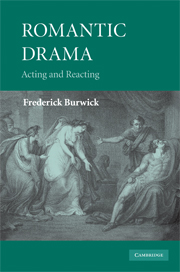Book contents
- Frontmatter
- Contents
- List of illustrations
- Acknowledgments
- Introduction
- 1 Periscopes into the theatre
- 2 Nationalism and national character
- 3 Genre: the realism of fantasy, the fantasy of realism
- 4 Acting: histrionics, and dissimulation
- 5 Transvestites, lovers, monsters: character and sexuality
- 6 Setting: where and elsewhere
- 7 Gothic and anti-Gothic: comedy and horror
- 8 Blue-Beard's castle: mischief and misogyny
- 9 Vampires in kilts
- Notes
- Bibliography
- Index
3 - Genre: the realism of fantasy, the fantasy of realism
Published online by Cambridge University Press: 04 August 2010
- Frontmatter
- Contents
- List of illustrations
- Acknowledgments
- Introduction
- 1 Periscopes into the theatre
- 2 Nationalism and national character
- 3 Genre: the realism of fantasy, the fantasy of realism
- 4 Acting: histrionics, and dissimulation
- 5 Transvestites, lovers, monsters: character and sexuality
- 6 Setting: where and elsewhere
- 7 Gothic and anti-Gothic: comedy and horror
- 8 Blue-Beard's castle: mischief and misogyny
- 9 Vampires in kilts
- Notes
- Bibliography
- Index
Summary
Never in the history of the drama was “a willing suspension of disbelief ” more essential to sustaining dramatic illusion, nor more operative in representing the magical and marvelous: not just the mixture of comedy and tragedy, but of pantomime and song in melodrama, of domestic realism and supernaturalism in Gothic romance. Audiences of the period delighted in plays that were richly embellished in song, that combined the thrills of adventure romance and the terrors of Gothic villainy, with a full indulgence of sentimental and the moral righting of wrongs necessary to a “happy ending.” The combinatory experimentation with dramatic form compromises any attempt at strict categorization. The anti-Gothic becomes a feature of the Gothic. The spectrum from fantasy to documentary is not linear, but rather a snake biting its tail. This chapter will challenge the presumed opposition between fantasy and realism by attending to the efforts to make the fantastic appear “real” on the stage. It will proceed to argue that documentary drama is equally committed to the theatrics of illusionism.
The optical metaphor of the periscope, introduced in Chapter 1, was intended to conjure the experience of joining an audience in the theatre and seeing a performance from that unique vantage of time and place. As an optical metaphor for what the audience saw unfolding on the stage, I propose “Pepper's Ghost.” This simple but effective illusion was developed by Henry Dircks and introduced by John Henry Pepper at the Royal Polytechnic (1862).
- Type
- Chapter
- Information
- Romantic DramaActing and Reacting, pp. 56 - 79Publisher: Cambridge University PressPrint publication year: 2009



